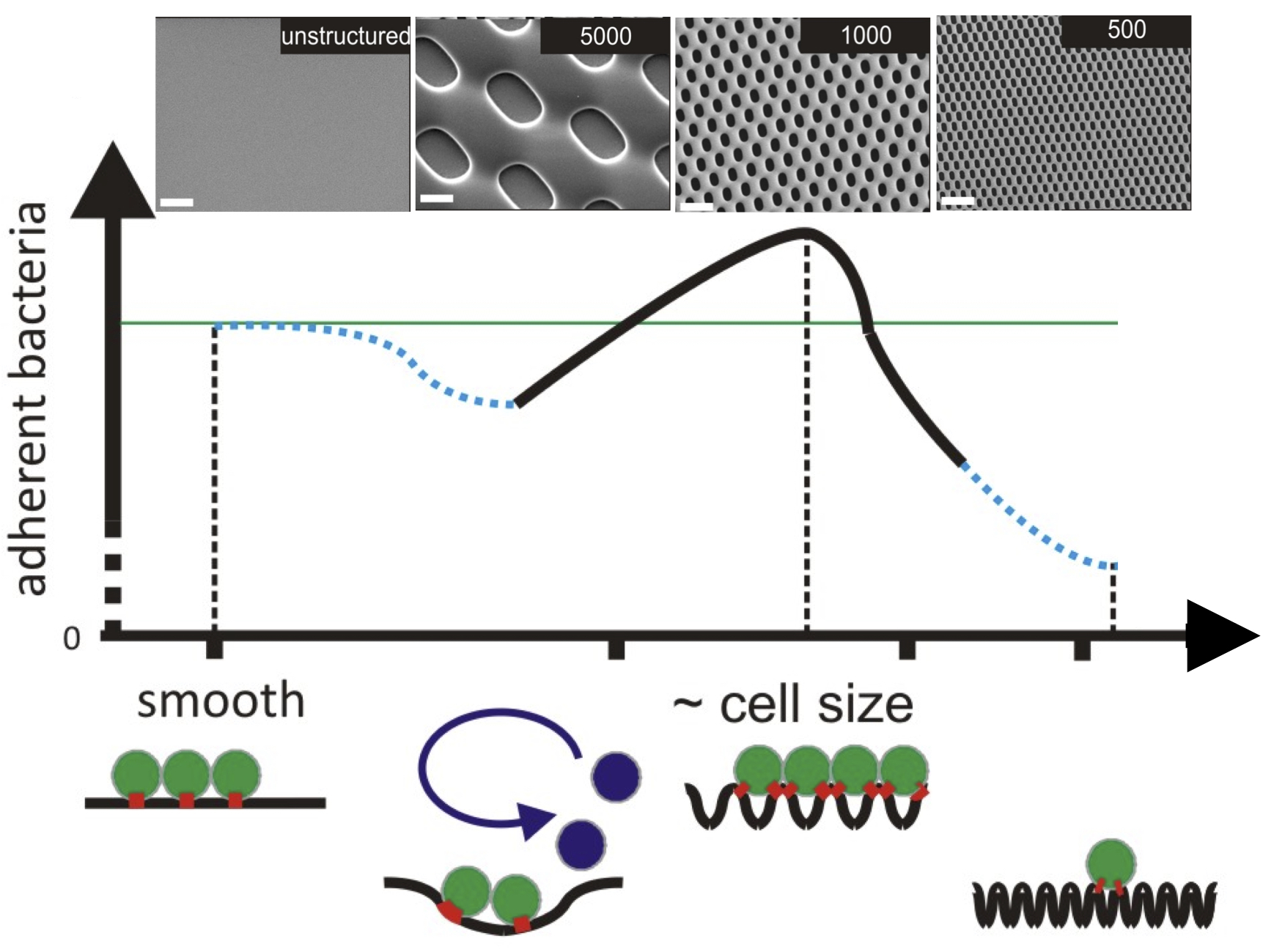Impact of structure-dimensions on initial and short-term bacterial adhesion
-
1
Leibniz Institue of Polymer Research, Institute of Biofunctional Polmer Materials, Germany
-
2
Dresden University of Technology, Large Area Based Surface micro-/nano-Structuring, Germany
Introduction: Bacterial biofilms on man-made surfaces can cause a multitude of negative consequences in industrial and medical environments. A central process in the formation of biofilms is the initial transition of planktonic bacteria to a sessile state by attaching to a given substrate. Besides environmental conditions, such as pH, temperature, competing organisms and nutrition, the initial interactions between bacteria and substrate are mainly influenced by interfacial properties such as chemistry, polarity, mechanical properties and structure. Previous studies have demonstrated fundamental effects of substrate topography on the initial adhesion phase although a comprehensive picture is still missing. Here we applied periodically structured substrates with different structure dimensions, types and wetting properties to systematically study the effect of surface topography on bacterial adhesion.
Material and Methods: Periodic line, post and hole structures were made by laser interference patterning from the slightly hydrophilic photoresist SU8. For each pattern geometry the spatial period was varied between 500 nm and 5000 nm. Surface wettability of the samples was varied by functionalization with aminosilan (APTES) or amorphous fluorpolymer TAF respectively. Structured samples were incubated in bacterial solutions (Staphylococcus epidermidis) at 37°C for 2 min or 24 hours with constant shaking. After the defined time periods samples were fixed, stained with DAPI and imaged.
Results and Discussion: We could show that the initial interactions (minutes to hours) of bacterial cells with structured surfaces strongly depend on the structure dimensions (Figure 1). On structured surfaces with structure periods several times bigger than the cells size (i.e. 5000nm in this study) the number of adherent bacteria decreases (in comparison to an unstructured control) since cells are detached from structure tops due to increased shear forces induced by turbulent liquid flow. However, cells within depressions of the structure are protected from shear forces. For periods close to the cell size (i.e. 1000nm in this study), cell attachment increases because of a maximized net contact area between cells and surface. Smaller periods (i.e. 500nm in this study) decrease the net contact area between cells and surface resulting in increased cell retention. The observed effects were independent on the contact time between bacteria and substrate, the wetting properties of the substrate and the structure type.
Conclusion: The presented results provide, for the first time, a comprehensive overview on the impact of surface topography on bacterial retention and may represent a foundation for the development of antifouling surfaces in the future.

Figure 1: Schematic representation of the dependency of the structure period on initial bacterial attachment.
Keywords:
Bacteria,
Cell Adhesion,
nanotopography,
Pattering
Conference:
10th World Biomaterials Congress, Montréal, Canada, 17 May - 22 May, 2016.
Presentation Type:
General Session Oral
Topic:
Nanotopography of biomaterials
Citation:
Helbig
R,
Friedrichs
J,
Lasagni
A and
Werner
C
(2016). Impact of structure-dimensions on initial and short-term bacterial adhesion.
Front. Bioeng. Biotechnol.
Conference Abstract:
10th World Biomaterials Congress.
doi: 10.3389/conf.FBIOE.2016.01.01503
Copyright:
The abstracts in this collection have not been subject to any Frontiers peer review or checks, and are not endorsed by Frontiers.
They are made available through the Frontiers publishing platform as a service to conference organizers and presenters.
The copyright in the individual abstracts is owned by the author of each abstract or his/her employer unless otherwise stated.
Each abstract, as well as the collection of abstracts, are published under a Creative Commons CC-BY 4.0 (attribution) licence (https://creativecommons.org/licenses/by/4.0/) and may thus be reproduced, translated, adapted and be the subject of derivative works provided the authors and Frontiers are attributed.
For Frontiers’ terms and conditions please see https://www.frontiersin.org/legal/terms-and-conditions.
Received:
27 Mar 2016;
Published Online:
30 Mar 2016.
*
Correspondence:
Dr. Ralf Helbig, Leibniz Institue of Polymer Research, Institute of Biofunctional Polmer Materials, Dresden, Germany, Email1
Dr. Andrés Lasagni, Dresden University of Technology, Large Area Based Surface micro-/nano-Structuring, Dresden, Germany, Email2
Dr. Carsten Werner, Leibniz Institue of Polymer Research, Institute of Biofunctional Polmer Materials, Dresden, Germany, Email3